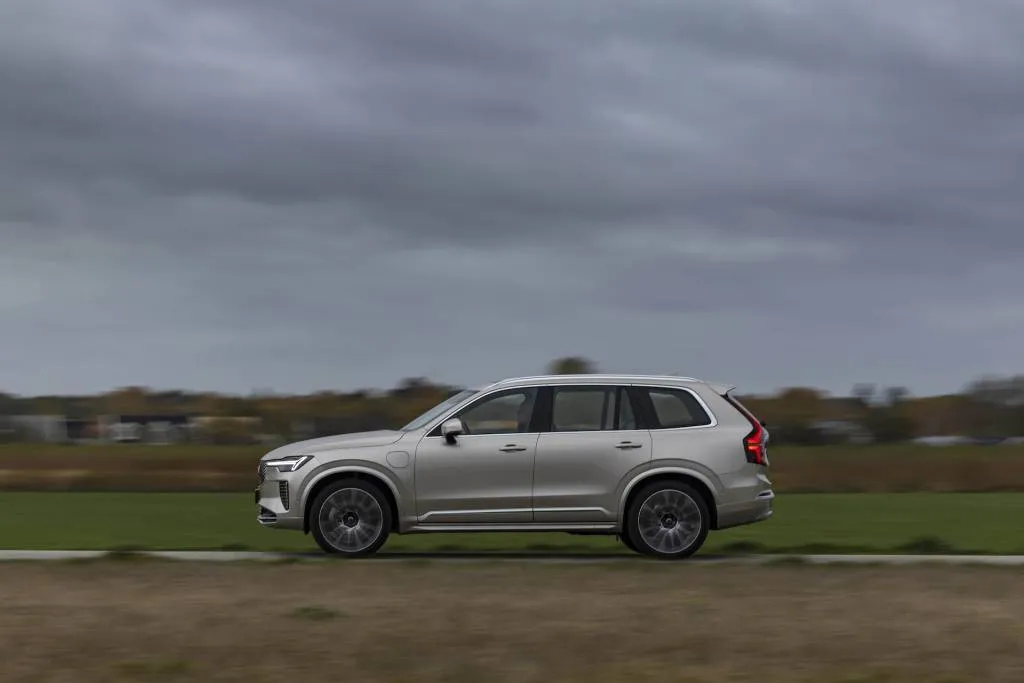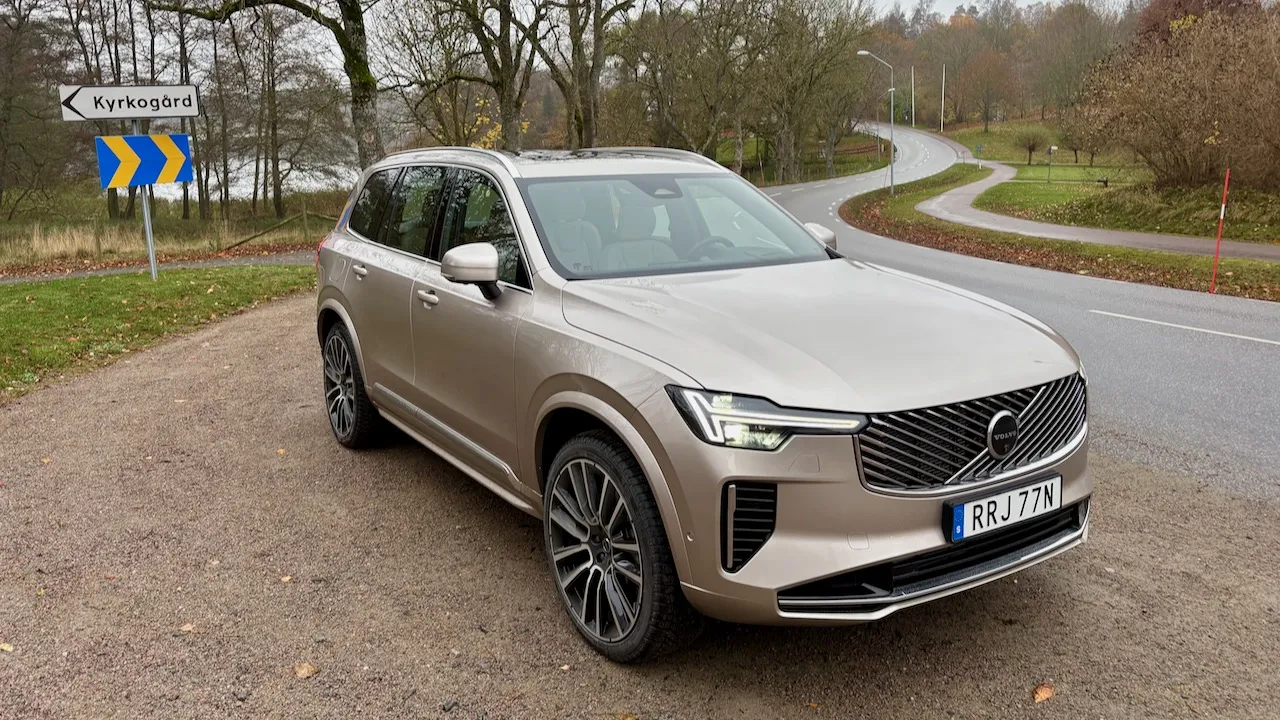- XC90 plug-in wears fresh face, revamped interior
- It inherits EX90 EV’s interface and OTA update capability
- EPA-rated EV range should be 33 electric miles
- Core, Plus, Ultra trim packages; six- or seven-passenger versions
- XC90 Core costs $59,745; Ultra, $81,495
Søren Kierkegaard had it right: life must be lived forwards. Still, not every new-SUV buyer is ready for what lies ahead in the all-electric-car era.
When they are, Volvo’s ready. It has the pert little Volvo EX30 hatchback soon dribbling into showrooms, and the sumptuous Volvo EX90 three-row electric SUV that makes a strong case for a transition away from gas.
But Volvo won’t be all-electric by 2030 as it had planned. It won’t chase the last bits of ICE car business, but it will evolve its plug-in hybrids and lean on them more heavily than it had once planned.
For 2025, as it rolls with the electrified tide, Volvo will update its best hybrid and one of its bestselling vehicles ever. The 2025.5 Volvo XC90 (yes, it’s a rare half-year intro) gets more sound insulation, finer interior materials, a new touchscreen with an updated interface borrowed from the EX90, and a revamped suspension to accompany its restyled front and rear ends.
It’s no hard reboot. The XC90 still feels familiar—but not stale. That’s critical, since there’s no doubt the plug-in hybrid, part of a lineup introduced a decade ago, will play a much bigger role at Volvo for the remainder of the decade.
2025.5 Volvo XC90 T8 PHEV test drive review, Copenhagen
Volvo XC90: Stately and low-key stunning
Subtle changes to the exterior and interior marks the latest iteration of the XC90. The most striking? A new front end with a grille consisting of diagonal slats—a callback to its traditional diagonal-bar grille—and a stronger brand mark. It’s framed in bright trim, and pinned to the nose by slim hammer-style LED matrix headlights. Stylists resculpted the hood and front fenders around the headlights, sketched out new wheel designs, tinted the rear lights dark, and specified a deep new red to mark the changes.
What they haven’t touched: The XC90’s sturdy but svelte wagon body, and the substantial impression it makes.
It’s simpler to spot the changes inside the XC90. At the center of the dash, a larger 11.2-inch touchscreen stands proud where a 9.0-inch screen once took up dash space. Vertical air vents bracket it and the rest of the dash, which now wears panels trimmed in recycled fabric tailored to complement cut-aluminum speaker grilles and wood trim.
New lighting brings drama to those finishes; there’s a white-wood palette with a Hollywood Regency vibe, a subdued charcoal-gray setup, and—best of all—nut-brown ash paired with cardamom-brown fabric, which sends all kinds of pumpkin spice vibes to the blue-burban households that the XC90 targets with laser precision.

2025.5 Volvo XC90 T8 PHEV test drive review, Copenhagen
2025.5 Volvo XC90 T8 PHEV: EV lite?
On a misty November morning outside of Copenhagen, I twist the start knob on the XC90 plug-in to life and set out on a Google-mapped journey across the Øresund bridge-and-tunnel tandem, into southern Sweden, to see if the updated XC90 held many surprises—other than suiting up as a perfect match for the kind of commuter duty I live with now, lots of short stints punctuated by a long-distance haul once a month or less.
For those who don’t want to bother with a plug-in, the 2025.5 XC90 still offers a choice of a 247-hp turbo-4 coupled to an 8-speed automatic and standard all-wheel drive. The turbo- and supercharged version of the same engine cranks out 310 hp. Both have mild-hybrid systems to skimp on fuel. First, I drove the base model, in Ultra trim with white wood and a marvelous denim-blue woven interior. I whittled away miles of Swedish farmland without a foot fault, despite the car being shod with big 21-inch wheels and being without the available air suspension.
The PHEV fits my daily-driving cycle better, though—especially since free, low-speed charging is a five-minute walk away. It’s no wonder Volvo calls the XC90 T8 its “backup plan.” To the supercharged turbo-4 in other grades the T8 adds an 18.8-kwh lithium-ion battery pack, with 14.7 kwh of that usable. It’s the same battery found in many of Volvo’s revamped plug-in hybrids. With the additional 145 hp and 228 lb-ft it pairs with the engine’s output, its net 455 hp and 523 lb-ft of torque will push the chunky, nearly 5,000-pound SUV to 60 mph in 5.0 seconds while it generates an EPA-estimated 33 miles of all-electric power.
That’s a half-week’s worth of driving on electricity for me—and today it tours me around south Swedish counties with all the diacritical marks a budding linguist could ask for. It’s unchanged at the powertrain level, but with the refined interior comes thick acoustic glass and sound-deflecting materials that deaden road noise—and leave space for the spatial greatest hits of the Bowers & Wilkins audio system and the strains of Fleetwood Mac.
Through its onboard 6.4-kw charger, the XC90 PHEV can top off its battery in about five hours on a Level 2 charger. It can conserve battery power for later by toggling through a series of drive modes, too. For now, there’s no word on the arrival of a Tesla-based NACS charge port. That would triple the available charging options where I live. For me, and for many drivers, the XC90 PHEV can act like a pure EV.

2025.5 Volvo XC90 T8 PHEV test drive review, Copenhagen
2025.5 Volvo XC90 T8 PHEV: A well-controlled ride
When it can’t, the engine power that backs it up can be spun through a set of drive modes that add to the Pure EV mode the choices of Hybrid, Power, Off-Road, and Constant AWD. Once I’ve exhausted almost all the battery power, the whir of the engine clicks on in the background and I choose Hybrid mode, to keep speed in check.
With its net 455 hp, the XC90 still doesn’t press limits. It’s measurably, observably quick, but the combination of its substantial curb weight and well-sorted 8-speed automatic means that power builds in a predictable line, with battery filling in where turbo lag might drop out torque. It’s strong, but not overwhelming—and the power transitions seem smoother as well. A “B” drive mode engages more regenerative braking, but it’s not enough to leave the brake pedal for special occasions, like a pure EV’s one-pedal drive might enable.
As for its ride and handling, the XC90’s available air-suspension upgrade reaps instant, comprehensive rewards. Where the multi-link front, integral-link-and-leaf rear suspension of the base car had spells of disagreement with the few patches of bad pavement I drove over, the air suspension negated them all, even on winter tires fitted in anticipation of a real season. It’s capable of 8.1-8.5 inches of ground clearance, and can tow up to 5,000 pounds—but in these parts of the Baltics, the rugged driving’s confined mostly to muddy rural farm trails.
The XC90’s better reserved for the road, in any case. Light steering, without much feedback, and the constant filtering of road imperfections loads up the XC90 with one of its secret weapons—ride quality and composure on winding roads. It’s sorted well enough to make even more complicated suspension setups—like the active anti-roll damping on big Benz and BMW SUVs—seem a step too far.

2025.5 Volvo XC90 T8 PHEV test drive review, Copenhagen

2025.5 Volvo XC90 T8 PHEV test drive review, Copenhagen

2025.5 Volvo XC90 T8 PHEV test drive review, Copenhagen

2025.5 Volvo XC90 T8 PHEV test drive review, Copenhagen
2025.5 Volvo XC90 goes for Google while it stands with Apple CarPlay
Under the skin the XC90 hasn’t altered its expansive cabin. It’s still 195.0 inches long, on a 117.5-inch wheelbase, and comes in either a seven-passenger configuration with a middle-row bench seat or in a six-passenger model with that bench replaced by twin captain’s chairs.
Volvo bathes the cabin in light through a panoramic glass roof, and sets up passengers for long-distance comfort with benchmark-grade seats. The front chairs have well-pocketed bottom cushions, available cooling and massaging, and even in the base interior, near-perfect cushion firmness. Volvo’s Nordico synthetic leather gets quilted for appearance, but the recycled material in the base car I drove looked even better—like the denim of a vintage pair from jeans found on Japanese eBay.
Front-seaters also get a reshaped center console with a wireless smartphone charging pad in front, and twin cupholders that can hide under a sliding tambour. Second-row passengers in captain’s chairs have access to cupholders, seat heaters, and a central pass-through to the third-row seat—but they’ll want to stop shy of the wayback if they’re medium-sized or larger.
It’s just short of enough room for big people to fit in both the second and third rows at the same time; legroom specs check in at 36.6 inches and 31.9 inches, respectively. All XC90s have three rows, but the rear two rows can be folded away to boost cargo space from 9.3 cubic feet behind the third row, with cargo loaded only to the glass line, to 70.8 cubic feet behind the front seats, fully packed like a Swedish Joad family headed west with every earthly possession in tow.
On deck from the driver’s seat, Volvo’s extensive safety systems now have audible speed-limit warnings that can be canceled with a tap on the left steering-wheel controller, as well as camera aids for parallel parking and the usual adaptive cruise control with Drive Pilot hands-free driver assistance. The updated touchscreen has ditched Volvo’s Sensus OS and its infrared-sensitive display for a conventional capacitive screen with Google built-in and an interface developed for the EX90 EV. It’s Google underpinnings, but it still offers Apple CarPlay and incorporates over-the-air update capability.
Prices for the updated XC90 start at $59,745 with standard gear that includes the mild-hybrid turbo-4, all-wheel drive, and seats for seven, as well as a panoramic sunroof, a power tailgate, 20-inch wheels, front and rear parking sensors, quilted Nordico synthetic leather upholstery, heated front seats, a stitched dash panel, an Orrefors crystal gear shifter, power front seats, 220-watt audio, adaptive cruise control, blind-spot monitors, active lane control, and those pesky speed-limit warnings. The six-passenger version adds $500, in any model.
The $63,485 XC90 Plus gets a second-row center booster seat, a surround-view camera system, 21-inch wheels, camera/audio-assisted parallel parking, acoustic glass, and heated rear seats. For $68,245, the XC90 Ultra adds cooled front seats with nappa leather, front-seat lumbar adjustment, Harman Kardon audio, power side bolsters and front-seat extended bottom cushions, and a head-up display.
Options are few: massaging front seats, 22-inch wheels, Bowers & Wilkins sound, the air suspension, and that snazzy navy herringbone woven upholstery.
An upgrade to the supercharged turbo-4 brings prices to $64,645 (Core), $67,445 (Plus), and $71,845 (Ultra). For the T8 PHEV, it’s $74,295 for the Core, $77,095 for the Plus, and $81,495 for the Ultra.
With some overlap with the 2025 model, the 2025.5 XC90 arrives in showrooms in the first quarter of 2025. It’s a backup plan for the EV future, for sure—but for plenty of drivers, the backup plan’s better than just about anything else.
Volvo paid for travel expenses so we could strafe greater Copenhagen and bring you this test-drive review.
